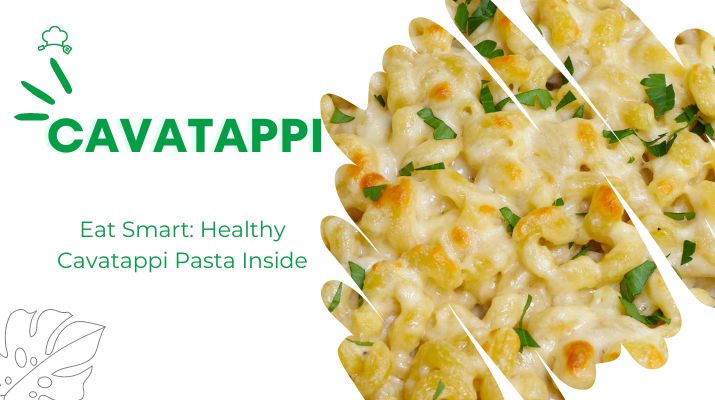Introduction
Welcome to this comprehensive guide solely devoted to cavatappi and cavatappi pasta! If you’ve been pondering how this intriguing pasta type can be part of a health-conscious lifestyle, then you’ve landed on the perfect article. We’ll be shining the spotlight on cavatappi, exploring everything from its origins and nutritional benefits to its flexibility in various scrumptious recipes. This post is tailor-made for pasta enthusiasts who have a particular fondness for cavatappi and want to relish it without sidelining their health goals. So, without further ado, let’s delve deep into the fascinating world of cavatappi, a pasta that not only pleases the palate but can also fit into a balanced diet.
What Is Cavatappi?
So, what exactly is cavatappi? The word “cavatappi” is derived from the Italian words for “corkscrew,” aptly describing its unique spiral shape. This distinct form doesn’t just give it a beautiful appearance on the plate but also has practical applications. The twists and turns are perfect for holding onto sauces, allowing for a balanced bite that is both flavorful and satisfying.
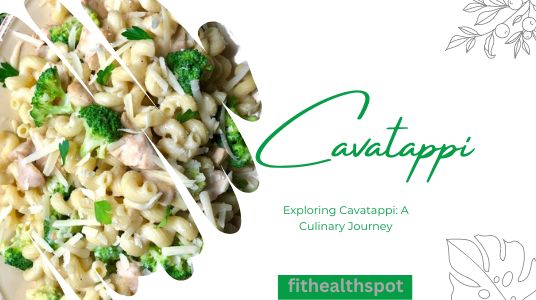
In the world of pasta, where there are over 600 types, cavatappi holds its own with its signature curves and versatility. It pairs well with a variety of sauces and can be used in different culinary applications, from salads and casseroles to the beloved mac and cheese.
Not only is cavatappi delightful to eat, but its shape also allows for a more even distribution of sauce to pasta ratio. This could be a boon if you’re mindful of your caloric intake, as you can get maximum flavor with less sauce, thereby reducing the overall calorie count of your dish.
What Is Cavatappi Pasta?
When we talk about pasta, what often comes to mind are the classic varieties: spaghetti, penne, and macaroni, to name a few. But what sets cavatappi pasta apart from its more familiar counterparts? The answer lies in its unique form and texture, characteristics that not only impact its culinary uses but also its nutritional offerings when incorporated in a balanced diet.
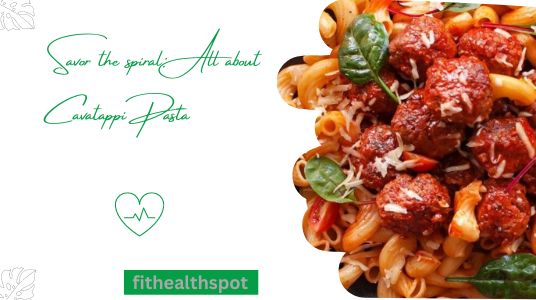
A Shape Like No Other
At first glance, cavatappi pasta immediately captivates with its corkscrew shape, a feature that provides it a unique texture and eating experience. Unlike straight-cut pasta like spaghetti or tubular shapes like penne, cavatappi pasta has a helical structure. This interesting design serves more than just an aesthetic purpose. The spirals act as tiny pockets that trap sauces, seasonings, and even small chunks of ingredients, allowing for a richer and more flavorful bite.
A Different Texture, A Different Experience
Texture plays a critical role in how we experience food, and cavatappi pasta offers a unique ‘bite’—a quality chefs refer to as ‘al dente.’ When cooked properly, it retains a firm yet chewable texture that perfectly balances its usually softer accompaniments like sauces or vegetables. The end result is a harmonious blend of flavors and textures that make each dish featuring cavatappi pasta distinct and enjoyable.
Why It Matters For Your Health
Cavatappi pasta’s unique form enables better sauce retention, meaning you can actually use less sauce to achieve the desired flavour profile. This has potential health implications, particularly if you’re mindful about reducing sugar or salt content in sauces. The shape may also slow down the speed at which you eat, aiding in better digestion and possibly even reduced caloric intake.
Nutritional Profile of Cavatappi Pasta

When talking about pasta and health, the conversation inevitably gravitates towards its nutritional aspects. So, what does cavatappi pasta bring to the table in terms of nutritional value? Let’s break it down.
Macronutrients and Micronutrients
Similar to other types of pasta, cavatappi is primarily made of wheat, making it a rich source of carbohydrates. A single serving generally offers a good amount of protein, minimal fat, and a significant dose of essential nutrients like fiber, iron, and B-vitamins. Its nutritional content can, of course, vary based on the brand or if it is made from alternative ingredients like whole wheat or gluten-free flours.
Health-conscious Choices
If you’re interested in maximizing the health benefits of your pasta dish, opt for cavatappi made from whole-grain or enriched flours. These alternatives not only offer more fiber but also a broader spectrum of nutrients compared to regular pasta. As we often discuss, the right choice of ingredients can make a world of difference in the nutritional profile of a dish, much like choosing to incorporate green tea shots for their health benefits or selecting smoked salmon for its omega-3 fatty acids.
Portion Control and Pairings
While pasta is undeniably delicious, moderation is key. Being mindful of portion sizes can help you enjoy your cavatappi pasta without overindulging. Pair it with protein-rich toppings and nutrient-dense vegetables to create a balanced meal.
Health Benefits of Cavatappi Pasta

When it comes to health and well-being, every food choice we make counts, and pasta is no exception. Though often cast in a less favourable light due to its carbohydrate content, certain types of pasta—cavatappi included—can offer some noteworthy health benefits when incorporated into a balanced diet.
A Better Carb Option?
Compared to some other types of pasta, cavatappi’s unique shape allows for better sauce retention, potentially reducing the amount of sauce—and thereby sugar or sodium—you consume. Additionally, if you opt for cavatappi made from whole grains or enriched flours, you’re also getting a decent dose of essential nutrients like fiber, iron, and B vitamins.
Digestive Health
The fiber content in whole-grain cavatappi pasta is an asset to your digestive system. Fiber aids in digestion and can contribute to lower cholesterol levels. It is a crucial component for anyone looking to maintain a balanced and healthy diet.
Versatility in Health-conscious Recipes
Cavatappi pasta offers a unique twist to traditional pasta recipes, which may enable you to incorporate more health-conscious ingredients. For example, its spirals can hold more vegetables, allowing you to up the nutritional content of your meals. If you’re looking to diversify your sources of plant-based nutrients even further, consider incorporating buckwheat flour into your cooking repertoire for additional health benefits.
Making the Right Choices
Like all foods, the health benefits of cavatappi pasta largely depend on what you pair it with. Opt for lean proteins and a variety of vegetables to make your cavatappi dish a nutritional powerhouse. It’s all about making wise choices, similar to selecting other health-boosting foods like green tea shots or smoked salmon.
Cavatappi vs. Other Pasta Types
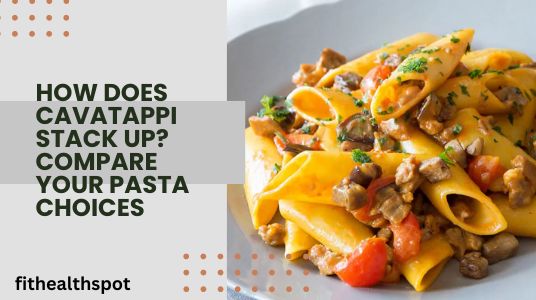
In the vast landscape of pasta, each type brings its unique attributes to the table, both in terms of culinary value and nutritional content. So how does cavatappi fare when compared to other well-known types of pasta such as macaroni, spaghetti, and penne?
Cavatappi Noodles: The Shape Advantage
One of the most distinctive features of cavatappi noodles is their corkscrew shape. Unlike the straight form of spaghetti or the small, tubular shape of macaroni, cavatappi’s spirals allow for an entirely different culinary experience. This shape not only aids in holding sauces better but can also make your dish visually appealing.

Nutritional Comparison
When it comes to nutritional value, cavatappi noodles share many similarities with other pasta types, particularly if made from the same type of flour. However, the option to use whole-grain cavatappi can give you a slight edge in terms of fiber content, similar to how switching to oat bran can provide added nutritional benefits over regular oats.
Versatility in Cooking
Cavatappi’s unique form makes it exceptionally versatile in the kitchen. It pairs well with both light and hearty sauces and can hold its own in baked pasta dishes, which is something that can’t always be said for more delicate noodles like spaghetti.
Ideal For Certain Diets
For those following specific dietary needs, cavatappi offers variants like whole-grain or gluten-free options, much like other pasta types. Depending on what you pair it with, cavatappi can be adapted to suit low-fat, high-protein, or even vegetarian diets.
The Importance of Portion Control with Cavatappi
In the realm of health and fitness, portion control is paramount. This principle holds true for all foods, including our subject of focus—cavatappi. While cavatappi has its own unique benefits, overindulgence can negate those positives.
Measuring Your Servings
A standard serving of cavatappi, like most pasta types, is usually around 2 ounces dry or 1 cup cooked. Keeping tabs on your servings can help you manage caloric intake and better align your diet with your fitness goals.
The Role of Meal Timing
Incorporating a moderate portion of cavatappi into a balanced meal plan can help you manage your weight and energy levels, especially when coupled with intermittent or dry fasting techniques. For a deeper dive into the relationship between meal timing and health, you might find our guide on intermittent and dry fasting helpful.
Cavatappi Recipes: The Healthy Way

When it comes to relishing cavatappi, you have plenty of room for creativity while keeping health in mind.
Whole-Grain Cavatappi Salad
A refreshing mix of whole-grain cavatappi, cherry tomatoes, arugula, and a light vinaigrette can serve as a balanced, nutrient-rich meal.
Cavatappi with Grilled Vegetables
Combine grilled zucchini, bell peppers, and cavatappi for a dish that’s as colorful as it is nutritious.
Pesto Cavatappi: A Healthy Twist
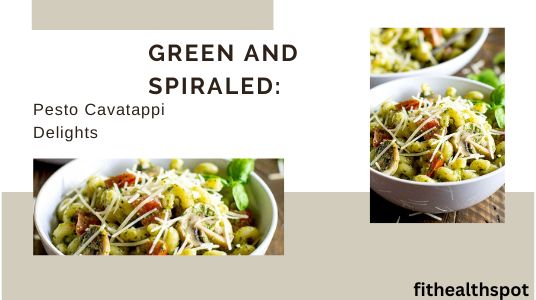
One beloved way to enjoy cavatappi is with pesto sauce. In our healthy version, replace traditional basil pesto with a kale and walnut pesto for added nutrients and a unique flavour profile.
Southwest Beef Cavatappi: Protein-Packed, Low-Fat
For a meal that’s satisfying and health-conscious, consider a Southwest Beef Cavatappi dish. Use lean ground beef, black beans, and whole-grain cavatappi for a protein-packed meal that’s low in saturated fats.

Chicken Cavatappi: A Veggie-Boosted Dish
When it comes to pasta, incorporating lean proteins and a bounty of vegetables can turn a simple dish into a balanced meal. Chicken Cavatappi is no exception.

Ingredients and Preparation
Start with grilled chicken breast, as it is lower in fat than other cuts. Add an assortment of vegetables like bell peppers, zucchini, and spinach. Mix these with cavatappi and a light garlic sauce, and you’ve got a dish that’s not only tasty but also nutrient-rich.
Cavatappi Mac and Cheese: A Healthier Twist

Mac and Cheese is the epitome of comfort food, but it’s often laden with saturated fats and simple carbs. However, a few tweaks can turn it into a healthier option without sacrificing taste.
A Fresh Take
Switch out regular cheddar for reduced-fat cheese and use whole-grain cavatappi. Add some steamed broccoli or cauliflower for extra fiber and nutrients. The result is a Cavatappi Mac and Cheese that you can enjoy guilt-free.
Customizing Your Cavatappi Pasta Dish
While cavatappi pasta is delicious in its traditional form, customization can make it even better—especially when it comes to health.
Choose Whole Grains
Opt for whole-grain cavatappi for extra fiber, which aids in digestion and helps maintain steady blood sugar levels.
Control Fats
Instead of cream-based sauces, opt for lighter options like olive oil-based sauces or tomato-based alternatives. Add omega-3 rich options like walnuts or flax seeds for a nutritional boost.
Load Up on Veggies
Incorporate a variety of colorful vegetables to increase the dish’s vitamin and mineral content. The greater the variety of colors on your plate, the wider the spectrum of nutrients you’re likely to intake. The greater the variety of colors on your plate, the wider the spectrum of nutrients you’re likely to intake.Serving Suggestions for Cavatappi Pasta
Elevate your cavatappi dishes by pairing them with healthy sides and beverages that complement their flavors and nutritional profile.
Healthy Sides
Consider a side of steamed vegetables like asparagus or Brussels sprouts, which not only add color to your plate but also provide additional fiber and vitamins. A fresh garden salad with a light vinaigrette can also be a great accompaniment.
Beverages to Consider
When it comes to beverages, opt for ones that are low in added sugar. Herbal teas or infused waters can be excellent choices, adding to the meal’s enjoyment without piling on extra calories.
Cavatappi Pasta with Cream Sauce: A Guilty Pleasure?

Cream sauces are often the culprit behind calorie-heavy pasta dishes. But can a creamy cavatappi pasta dish be made healthier? Absolutely.
Healthier Cream Sauce Alternatives
Instead of heavy cream, you can use Greek yogurt or a plant-based milk alternative thickened with a small amount of cornstarch. Add flavor with herbs like basil and oregano rather than relying on salt and butter. This will give you that creamy texture without the extra fat and calories.
Conclusion
We’ve traveled quite a culinary and nutritional journey with cavatappi pasta. From its distinctive shape and texture to its versatility in a variety of dishes, cavatappi can certainly find a place in a health-conscious diet. Remember, the key lies in the ingredients you choose and how you portion your servings. Now, it’s your turn to give these healthy cavatappi pasta recipes a try.
Frequently Asked Questions (FAQs)
Is Cavatappi Pasta Healthy?
Cavatappi pasta can be part of a balanced diet when consumed in moderation and paired with healthy ingredients. Whole-grain versions offer more fiber and nutrients than their refined counterparts.
Is Cavatappi Pasta Gluten-Free?
Traditional cavatappi pasta is made from wheat and contains gluten. However, gluten-free options made from alternative flours like rice or corn are available in the market.
Where Can I Buy Cavatappi Pasta?
Cavatappi pasta is widely available in grocery stores, usually in the pasta aisle. You can also find it in specialty Italian shops or purchase it online.
How to Cook Cavatappi Pasta?
To cook cavatappi pasta, bring a large pot of salted water to a boil. Add the pasta and cook according to package instructions until al dente. Drain and mix with your desired sauce and ingredients.
What Makes Cavatappi Different from Other Pasta Types?
The unique corkscrew shape of cavatappi makes it excellent for holding onto sauces and flavors, setting it apart from other pasta types like spaghetti or macaroni.

